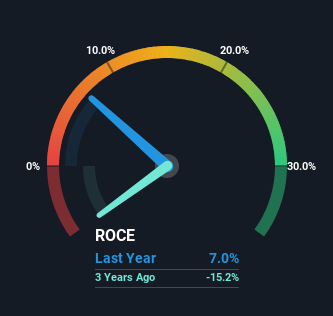- Canada
- /
- Oil and Gas
- /
- TSX:JOY
We Like These Underlying Return On Capital Trends At Journey Energy (TSE:JOY)
There are a few key trends to look for if we want to identify the next multi-bagger. In a perfect world, we'd like to see a company investing more capital into its business and ideally the returns earned from that capital are also increasing. This shows us that it's a compounding machine, able to continually reinvest its earnings back into the business and generate higher returns. With that in mind, we've noticed some promising trends at Journey Energy (TSE:JOY) so let's look a bit deeper.
Understanding Return On Capital Employed (ROCE)
For those who don't know, ROCE is a measure of a company's yearly pre-tax profit (its return), relative to the capital employed in the business. To calculate this metric for Journey Energy, this is the formula:
Return on Capital Employed = Earnings Before Interest and Tax (EBIT) ÷ (Total Assets - Current Liabilities)
0.07 = CA$34m ÷ (CA$589m - CA$102m) (Based on the trailing twelve months to September 2023).
So, Journey Energy has an ROCE of 7.0%. Ultimately, that's a low return and it under-performs the Oil and Gas industry average of 9.8%.
View our latest analysis for Journey Energy

In the above chart we have measured Journey Energy's prior ROCE against its prior performance, but the future is arguably more important. If you're interested, you can view the analysts predictions in our free report on analyst forecasts for the company.
So How Is Journey Energy's ROCE Trending?
The fact that Journey Energy is now generating some pre-tax profits from its prior investments is very encouraging. Shareholders would no doubt be pleased with this because the business was loss-making five years ago but is is now generating 7.0% on its capital. And unsurprisingly, like most companies trying to break into the black, Journey Energy is utilizing 71% more capital than it was five years ago. This can tell us that the company has plenty of reinvestment opportunities that are able to generate higher returns.
On a related note, the company's ratio of current liabilities to total assets has decreased to 17%, which basically reduces it's funding from the likes of short-term creditors or suppliers. This tells us that Journey Energy has grown its returns without a reliance on increasing their current liabilities, which we're very happy with.
The Bottom Line On Journey Energy's ROCE
Overall, Journey Energy gets a big tick from us thanks in most part to the fact that it is now profitable and is reinvesting in its business. And investors seem to expect more of this going forward, since the stock has rewarded shareholders with a 62% return over the last five years. Therefore, we think it would be worth your time to check if these trends are going to continue.
On a final note, we found 3 warning signs for Journey Energy (2 are a bit concerning) you should be aware of.
While Journey Energy may not currently earn the highest returns, we've compiled a list of companies that currently earn more than 25% return on equity. Check out this free list here.
New: Manage All Your Stock Portfolios in One Place
We've created the ultimate portfolio companion for stock investors, and it's free.
• Connect an unlimited number of Portfolios and see your total in one currency
• Be alerted to new Warning Signs or Risks via email or mobile
• Track the Fair Value of your stocks
Have feedback on this article? Concerned about the content? Get in touch with us directly. Alternatively, email editorial-team (at) simplywallst.com.
This article by Simply Wall St is general in nature. We provide commentary based on historical data and analyst forecasts only using an unbiased methodology and our articles are not intended to be financial advice. It does not constitute a recommendation to buy or sell any stock, and does not take account of your objectives, or your financial situation. We aim to bring you long-term focused analysis driven by fundamental data. Note that our analysis may not factor in the latest price-sensitive company announcements or qualitative material. Simply Wall St has no position in any stocks mentioned.
About TSX:JOY
Journey Energy
Engages in the exploration, development, and production of crude oil and natural gas in the province of Alberta, Canada.
Proven track record with moderate growth potential.
Market Insights
Community Narratives



